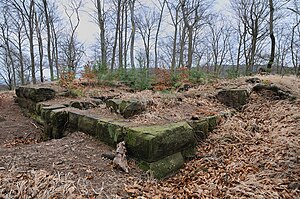Perlenberg Castle
| Perlenberg Castle | ||
|---|---|---|
| Alternative name (s): | Pearl castle, pearl castle | |
| Creation time : | around 1200 | |
| Castle type : | Hilltop castle | |
| Conservation status: | Wall remains | |
| Construction: | Humpback cuboid | |
| Place: | spell | |
| Geographical location | 49 ° 24 '54.4 " N , 7 ° 40' 5.9" E | |
| Height: | 371 m above sea level NN | |
|
|
||
The Castle Mountain pearls , also Perleburg or pearls Burg called, is the ruins of a hilltop castle in the municipality spell near Hohenecken in the district of Kaiserslautern in Rhineland-Palatinate .
location
The castle ruins are located in the area of the local community Bann on the "Small Mountain" near the "Roman hill settlement Großer Berg". It was strategically located on a small plateau 371 m above sea level , which slopes steeply all around. The purpose of their establishment was probably to control the road connection from Kaiserslautern to Landstuhl .
history
The "Perleburg" is a castle from the Hohenstaufen era that was probably never completed . It was likely to become part of the protective system built around the Kaiserpfalz Lautern in the 12th century, as indicated by the quality of the humpback blocks of the masonry. The name is not historical, but goes back to a document from 1542 (called Birleberg ), in which it comes to border disputes between the Electoral Palatinate and Sickingen. At that time the castle had long since fallen into disrepair.
It was only through archaeological excavations in 1901 by Christian Mehlis that the castle site was rediscovered and examined. In the following years the facility was probably used as a quarry, because in 1913 there were reports of numerous ashlar stones lying around, which today have almost all disappeared. Further excavations and security measures took place from 1959 to 1963.
Today the plant is owned by the State of Rhineland-Palatinate.
investment
Only the stump of a square keep with a profiled base and carefully carved humpback blocks has survived from the castle site . With a side length of around 9 m and a wall thickness of 1½ m, it has considerable dimensions and is thus comparable with the Bergfrieden of Landeck and Wildenberg . The base can be compared to Landeck's shield wall.
The high quality of the processing of the few remaining remains makes the “Perleburg” one of the most important Staufer castles in the Palatinate. Since there are no further traces of a castle complex apart from the tower stump, neither ruins nor any documentary evidence, it is reasonable to assume that the castle was never completed.
An underground corridor, which, according to a legend , is said to have connected the German gentry in Einsiedeln (Kaiserslautern) with the Perlenburg, could not be archaeologically proven. The legend comes from the so-called "Hummerplatz", a forest path along the former Sickingen border. It should sound hollow there if you stand firmly.
A path leads to the castle ruins, but it is not signposted. To find it you have to go to the Kolbenwoog from the Einsiedlerhof. At a multi-way junction, the path branches off to the left and in a few meters climbs the steep and isolated mountain cone. It is located in a natural forest reserve . If old castle guides still speak of excellent views, the summit plateau is now surrounded by tall trees.
literature
- Dehio , Gall : Handbook of the German art monuments Palatinate and Rheinhesse . German art publisher. 1951
- Friedrich-Wilhelm Krahe: Castles of the German Middle Ages - floor plan lexicon . Weidlich / Flechsig, Würzburg 1994. ISBN 3-8035-1372-3
- Magnus Backes: State castles, palaces and antiquities in Rhineland-Palatinate . Schnell & Steiner publishing house, Regensburg 2003. ISBN 3-7954-1566-7
- Arndt Hartung: Palatinate castle district . Walter Hartung Verlag, Ludwigshafen 1985. ISBN 3-9801043-0-3
- Jürgen Keddigkeit , Ulrich Burkhart, Rolf Übel : Palatinate Castle Lexicon IV.1 O-Sp . Institute for Palatinate History and Folklore Kaiserslautern, 2007. ISBN 978-3-927754-56-0

